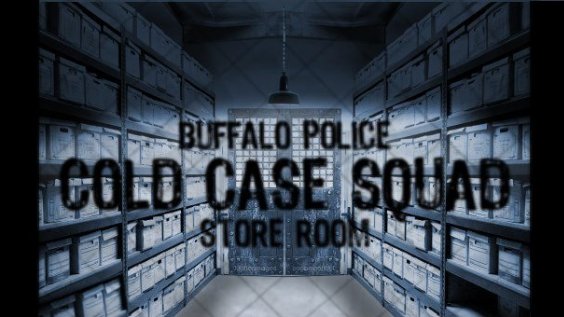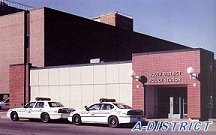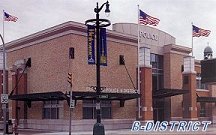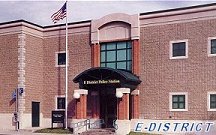|
|
|
Bernard Thomas Jr. was indicted in June for the 1975 murder
of Michelle Dixon.
Derek Gee / Buffalo News
Thomas found guilty in Cold Case murder trial
By Matt Gryta Buffalo News Staff Reporter
Bernard Thomas Jr. was found guilty late Thursday of
intentional second-degree murder for the fatal shooting of a
19-year-old Carl Street woman who also was sexually assaulted
almost 35 years ago.
The jury verdict followed a two-week trial before State
Supreme Court Justice Shirley Troutman. Thomas, 56, faces a
mandatory sentence of life in prison, will be sentenced on May
21.
The jury began deliberations about 1:40 p.m. Thursday.
Thomas, of South Division Street, who was 21 when the crime
was committed, has been jailed since he was arrested by
Buffalo Cold Case detectives last May.
During the trial, Thomas insisted a now-dead friend, James
Moran, shot Michelle Dixon after she and Thomas had sex in her
bedroom on May 20, 1975.
Thomas, who has a record of 56 arrests, was linked to the
crime through DNA evidence.
Prosecutors Gary W. Hackbush and Paul E. Bonanno presented
evidence that the victim was shot nine times in the head and
back and left in her bed face-down and covered by a blanket
and a pillow.
The jury heard the anonymous 911 call that prosecutors
proved was made by Thomas after he left the murder scene,
reporting that he had just heard shots fired at the Dixon
house at 52 Carl St.
In closing arguments, defense attorney Joseph A. Agro
repeated Thomas' testimony, that he and a friend had been
"partying" with drugs all night and had been having
frequent sex with the victim, who, he said, also was addicted
to drugs.
Prosecutors pointed out that Thomas gave police five
different versions of the woman's death, and told Cold Case
detectives last May that he accidentally shot her after sex.
Prosecutors also said an autopsy proved the murder victim
was not a drug addict.
They also noted that Thomas told police at various times
over the years that at least three other men could have killed
Dixon.
On April 1, the former Rhonda Clark, now married and living
out-of-state, testified she was Dixon's best friend and knew
she had no romantic interest in Thomas, although Thomas was
interested in her.
Clark testified that on the morning of the murder, she saw
Thomas walking down Carl, looking "kind of scared or
nervous."
mgryta@buffnews.com |
|
|
|

|
|
Cold-case
probe nets pastor in '98 slaying
Police
say he admits shooting 17-year-old
By
Lou Michel
BUFFALO News
Staff Reporter
November 09, 2009, 11:27 PM /
Cold
Case Squad detectives Monday arrested a West Side pastor in
the fatal shooting of a young father in front of the victim's
girlfriend and their infant son more than a decade ago.
Jose
G. Figueroa, 31, of Carolina Street, was charged with
second-degree murder in the killing of Alex Martinez, 17.
Several
individuals broke down a rear door at 392 Grant St. at 12:30
a.m. Jan. 29, 1998, and entered the Martinez residence. Then,
without saying a word, Figueroa allegedly fired a bullet into
the victim's head.
At
the time of the killing, then-Buffalo Homicide Bureau Chief
Joseph Riga said it appeared that Martinez had been targeted.
"They
didn't say anything. They just shot him in the head and left
through the same door," Riga said then.
Figueroa,
who described himself to police as a pastor and a full-time
cleaner, was located after homicide detectives received his
name from a tipster a few weeks ago.
When
cold-case detectives went to Figueroa's home Friday, he was
out but later contacted them and agreed to go to Police
Headquarters on Monday for an interview.
"Within
minutes after his arrival, he confessed to the murder of Alex
Martinez," said Cold Case Detective Brian G. Ross.
"I believe his strong faith and conscience led to his
willingness to confess."
Figueroa
explained to police that he had become a pastor since the
shooting, though he did not identify the church.
"He
was clearly a different person than at the time of the
homicide and has taken steps to carve out a better lifestyle
for himself and his family in the years since the
homicide," Ross said.
As
for Martinez's family members, they were notified Monday
afternoon that the case has been solved.
"They
are extremely grateful. They told me, "Now we can rest,"
Ross said.
As
for a motive for the deadly shooting, the detective said that
remains under investigation. The shooting originally was
thought to be drug-related, but Ross declined to comment on
that.
Assisting
in solving the case were other Cold Case Detectives Charles
Aronica and Lissacq M. Redmond along with State Police
Investigator Geraldo Rondon.
"This
is just an example of the outstanding police work done by our
Cold Case Squad, which I believe is one of the best in the
nation," said Deputy Police Commissioner Daniel Derenda,
who also credited homicide detectives for their help.
To
back up his praise of the Cold Case Squad, Derenda noted that
this is the eighth long- term unsolved homicide that has ended
in an arrest this year. Last year, 18 cold cases were solved,
and in 2007, 14 cases.
lmichel@buffnews.com |
|
|
|
|
|
Cold
Case team arrests suspect in ’93 slaying
By
Gene Warner BUFFALO NEWS STAFF REPORTER
03/14/09
Buffalo
Cold Case detectives have made an arrest in the beating death
of a 91-year-old woman in late 1993— a case that wasn’t
ruled a homicide until two years ago.
Mabel
I. Neuner, who had refused to move out of the Lang Avenue home
where she grew up, was beaten to death inside her home with a
blunt instrument during a burglary some time between Dec. 21
and 23, 1993, Buffalo police say.
On
Friday, John Butler, 32, of Dartmouth Avenue, was arraigned on
two second-degree murder charges before Erie County Judge
Sheila A. DiTullio. Butler has been in Marcy Correctional
Facility on a parole violation, police said.
While
police initially reported Neuner’s death as a homicide, the
Erie County medical examiner’s office officially labeled the
case as an “investigation pending” 15 years ago.
But
a review of the case two years ago by Cold Case detectives led
to the death being labeled a homicide.
“It
was changed to a homicide based on the scene photos and the
statements taken by police back in the 1990s,” Cold Case
Detective Brian Ross said Friday.
Butler,
who was 16 at the time, was known to homicide detectives
investigating the incident 15 years ago, but detectives
didn’t have enough evidence to build a case against him that
could be prosecuted, especially because the death hadn’t
been ruled a homicide.
Investigators
were somewhat tight-lipped Friday about what broke open the
case.
“It’s
based on statements obtained from witnesses and other people
that had been interviewed before,” Ross said. “Time
allowed them to be more forthcoming, apparently.”
Law-enforcement
sources said that a group of teens was burglarizing houses in
the area at the time.
“This
individual attacked her with a blunt instrument during the
course of the burglary,” one investigator said, citing the
evidence in the case.
Detectives
would not comment on whether any other people could be
arrested in this case.
Computer
records accessed by The Buffalo News show that a John Butler
with the same 1977 birth date has multiple local court
convictions for crimes that include assault, weapons
possession and reckless endangerment, among other charges.
Deputy
Police Commissioner Daniel Derenda credited the Cold Case
detectives who cracked the case: Detectives Ross, Lissa M.
Redmond, Charles Aronica and Mary E. Gugliuzza.
“It’s
another fine job by the Buffalo Homicide Squad and Cold Case
detectives,” Derenda said.
Cold
Case detectives last year solved 14 cases from previous years,
including nine or 10 from 2007 and the others from previous
years, Derenda said. So far this year, with Butler’s arrest,
homicide detectives have solved three cases from previous
years.
Neuner
was killed at the end of a very violent year in Buffalo. At
the time of her death, she appeared to be the 78th homicide
victim of the year, police said.
A
retired operating-room technician at the former Deaconess
Hospital, Neuner, who lived alone, resisted the pleas of
family members who urged her to move because the neighborhood
was too dangerous.
Police
said at the time that they believed Neuner opened her door to
her killer or killers. She most likely was forced into the
basement, before being bludgeoned with a blunt instrument and
left lying there.
Neuner
apparently wasn’t found until a day or two after her
killing.
gwarner@buffnews.com |
|
|
|
|
|
Ex-Buffalo
man charged in 1984 cold case murder
|
| Updated:
BUFFALO NEWS 05/19/08 1:24 PM
|
|
Cold
case detectives from the Buffalo Police Department have
arrested a former Buffalo man in connection with the
rape and murder of a Willowlawn Avenue woman more than
24 years ago.
|
| Edward
Richardson, 55, a former handyman who lived on Crescent
Avenue, appeared today before Senior Erie County Judge
Michael L. D'Amico.
|
| An
analysis of blood evidence from a nationwide DNA
databank led to the arrest of Richardson, who was being
held in a jail in the state of Washington on misdemeanor
charges.
|
| He
is accused of murdering Alma Strasner during a home
invasion at her residence on Willowlawn on April 7,
1984, Erie County District Attorney Frank J. Clark said.
|
| Clark
credited Detectives Charles Aronica and Mary Gugliazza
of the Buffalo Police Cold Case squad with recently
reopening the investigation and submitting blood
evidence for a DNA analysis.
|
|
At
the time of Strasner's death, police said she was
viciously raped and beaten in her home.
Assistant
District Attorney Thomas M. Finnerty is prosecuting the
case.
|
| He
pleaded not guilty to murder charges before D'Amico
today. |
|
|
|
 |
Col
d Case Squad clears a dozen old murder cases in just two years
DNA helps, but so do old-fashioned investigative techniques
By
Gene Warner NEWS STAFF REPORTER
01/21/08
Detectives
solved one 33-year-old murder when the key suspect spit into a
snowbank, and the detective scooped up the spittle, then
compared it with the DNA on fingernail clippings taken from
the homicide scene. It was a match.
Another
homicide, from 1994, was cleared when a reluctant witness
agreed to talk about the shooting death years later — but
only after the key suspect had been shot to death in a barroom
brawl.
|
|
|
And
Cold Case Squad detectives cracked one of their first
cases two years ago, helped by lab tests on DNA taken
from the stockings used to tie a 68-year-old woman’s
wrists to a bedpost.
The
Buffalo police Cold Case Squad is thriving.
|
| By
definition, these detectives tackle the hardest cases,
homicides lacking a smoking gun or a quick confession.
|
| Th
e squad, with only three detectives, has cleared about a
dozen old homicides since it was formed in March 2006. |
| Advances
in DNA technology, of course, have been the key.
|
| But
detectives also rely on the more traditional gumshoe
techniques — scanning databases of old homicides,
rereading old case files, looking for new witnesses,
re-interviewing old witnesses and resubmitting physical
evidence to the Erie County Central Police Services
labs.
|
| And,
oddly enough, they rely on strong detective work and
exhaustive police reports from their predecessors to
provide them the leads they’re chasing years later.
|
| Detectives
Lissa M. Redmond, Charles Aronica and Dennis A. Delano
— and a former squad member, Detective Mary E.
Gugliuzza — have shed new light on old cases.
They’ve brought some comfort or closure to the
families of Barbara Lloyd, Alvin Cosby and Sandra
Hainesworth, among others.
|
| Now
the families of Timothy Dzialak, Edward Myers Jr.,
Jermaine H. Lloyd and Journey W. Cooper III hope the
cold-case detectives can help those four victims rest in
peace also.
|
| “This
is the last thing in the world I can do for my only
son,” said Dzialak’s mother, Louella. “I want to
go to Timmy’s grave and say they’ve been put away
for what they did.”
|
| In
all three of these cases, surviving family members have
pushed hard for detectives to reopen their cases.
|
| “I
call them every week,” Louella Dzialak said. “I’m
like a thorn in their side. I don’t care. That’s my
son.”
|
|
Even
armed with the new DNA technology, cold-case detectives
still are stymied by the same problems that prevented
homicide detectives from making an arrest immediately
after any killing.
That’s
the case with Timothy Dzialak, the victim of a
particularly gruesome killing.
|
| ‘It’s
going on 10 years’
|
| On
Nov.
8, 1998
,
Dzialak’s body was found near railroad tracks in the
city’s Black Rock section. He had been shot in the
chest and his body set on fire.
|
| No
physical evidence has been linked to a possible killer.
No one has come forward to tell police exactly what
happened. And at least one of the people last seen with
Dzialak has refused to talk with detectives, on the
advice of his attorney.
|
| Louella
Dzialak is convinced that revenge was the motive. The
father of two of his friends had stabbed Timothy Dzialak
in the knee a few weeks earlier, police had charged.
|
| She
believes that four or five young people her son was with
the night before he was killed, including the two
brothers, were “in the thick” of the events
surrounding his killing.
|
| Cold
Case Squad detectives aren’t so sure that there was
any motive like that. They say Dzialak, 25, was involved
in a couple of shoving matches that night while drinking
with friends.
|
| “This
group of people, on weekends, they would drink heavily,
and it wasn’t out of the ordinary for them to get into
confrontations with each other,” Aronica said. “The
alcohol could have triggered the murder.”
|
| Louella
Dzialak and the cold-case detectives agree that a larger
group of people — including the killers’ friends and
relatives — could help them solve the case.
|
| “Nobody
wants to say anything,”
Redmond
said.
“People definitely know who did what, but no one’s
willing to take that leap and come forward and give us
names.”
|
| In
Louella Dzialak’s mind, that’s another crime that
has occurred in this case.
|
| “In
my heart, the people who know about it and haven’t
come forward are just as guilty,” she said.
|
| To
stir up new interest in the case,
Buffalo
police
last week posted an item on their Web site, announcing
an old $10,000 reward still in effect in the case. That
came after some prodding from Louella Dzialak. Anyone
with any information on this or any other case can call
the department’s confidential tip line at 847-2255.
|
| In
her many phone calls and meetings, Dzialak has gotten to
know the Cold Case Squad detectives. She says she likes
both Aronica and Redmond. But there remain tensions
between a still-grieving mother and the detectives
hoping to crack the case.
|
| “They
say they’re working on it, but you wonder if they
really are working as hard as they say they are,” she
said. “It’s going on 10 years.”
|
| The
Dzialak case shows one key principle guiding the Cold
Case Squad — not getting blinded by focusing on one or
two possible suspects.
|
| What
about the possible involvement of the two brothers whose
father was accused of stabbing Dzialak?
|
| “It’s
a possibility,” Aronica said. “I’m not eliminating
anyone [Dzialak] was with that night.”
|
| Advances
in technology
|
| Focusing
on one suspect is a cardinal sin in homicide
investigations. That’s why family members sometimes
are convinced they know who killed their relative, while
police try to keep a more open mind.
|
| “The
worst mistake you can make is to focus on one person,
because then you rule out everybody else,”
Redmond
said.
“You have to keep your options open, or you eliminate
your investigative avenues.”
|
| Cold
Case Squad detectives insist that no case has higher
priority than any other one. They scan computer lists of
homicides and reread old files, looking for cases that
are solvable even after several years. Often they send
old physical evidence back to the police lab, looking
for DNA results that weren’t obtainable years ago.
|
| “They
had no concept of DNA in the 1970s and ’80s,”
Redmond
said.
“That was like ‘Star Trek.’ They didn’t save
items we could get DNA off now, like a set of car keys
found at the scene. Where they dusted for fingerprints,
now we swab for DNA.”
|
| Redmond
cited
a key piece of evidence in the recent Bike Path Killer
case to make a point about the new methods now
available.
|
| “If
we had told a cop in 1977 that in 2007 we could tell who
committed a crime by a microscopic drop of sweat on a
steering column, they would laugh at us,” she said.
|
| Similarly,
Redmond
pointed
out that a dead end in a case today might not be a dead
end two years from now, the way technology is developing
so quickly.
|
| 3
victims, 3 families
|
| Cold
Case Squad detectives get to know many grieving families
from old cases, like Dzialak’s — mothers and
brothers and children of homicide victims who still are
consumed by their loved one’s unsolved killing.
|
| The
detectives mentioned their continuing investigations
into the slayings of three other victims whose relatives
have been pushing hard for the crimes to be solved:
|
| •
Edward Myers Jr., 29, whose body was found at
Guernsey
and
Farmer streets
Oct.
18, 1992
,
with several stab wounds. Detectives believe he might
have been involved in a fight at a bar on
Hertel
Avenue
.
|
| “Once
again, we have people of interest,”
Redmond
said.
“We think there is more than one person involved.”
|
| •
Jermaine H. Lloyd, 29, whose body was found
Nov.
4, 2001
.
He was kidnapped, held for ransom and then found shot to
death in a vehicle on
Humber
Avenue
,
police said.
|
| Detectives
believe he might have been set up to be robbed in a
drug-related crime. They also know that more than one
person had to be involved in the plot.
|
| “We
know there are people out there who know what happened,
and we want to talk to them,” Aronica said.
|
| •
Journey W. Cooper III, 17, whose body was found
in a
Grant
Street
stairwell
June
2, 2005
,
after he had been tortured and shot.
|
| “We
believe it’s gang-related,”
Redmond
said.
“We have a number of people of interest. We just need
a witness to come forward to tighten up the case.”
|
| Detectives
would love nothing more than cracking these cases.
|
| “It’s
very satisfying to solve it and call the family,”
Aronica said. “The family never forgets.”
|
| Dzialak
has another reason for wanting her son’s case closed.
Not only does she want to go to her son’s grave and
tell him his killers have been caught, she also wants to
be able to answer the questions and concerns of
Timothy’s son, William, 10.
|
| She
said, “He tells me all the time, ‘The bad people
should be put away for what they did, Grandma. The
police should be able to get them.’ ”
|
| gwarner@buffnews.com |
|
|
|
|

|
Dedicated
Cop Determined To Solve Bizarre Case
Dennis
Delano is the
Buffalo
,
N.Y.
detective
who recently helped solve a serial murder case that had been
plaguing his community for years.
Now,
he and the cold case squad of the Buffalo Police Department
are trying to unravel the case of Joan Giambra, a
Buffalo
area
woman who was brutally killed 13 years ago. What's more: the
killer left Joan's young daughter posed on top of her and left
for dead. But she survived, and could now help Dennis and his
team solve her mother's murder.
Dennis Delano is a local hero
in
Buffalo
. The 28-year veteran of law
enforcement helped to solve the
Buffalo
bike path rapist and serial
killer case and, in the process, set an innocent man
free. |
|
Detective
Dennis Delano Homicide Cold Case Squad |
|
| Now he's on
another mission. Every Sunday in church for the past year a
woman named Trisha has asked him to look into her sister's
murder from 1993. He's been so busy with his serial
killer case he hadn't had time. Until now. Now, he
has grabbed ahold of a bizarre 13-year-old crime that he says,
"I will solve."
He wants AMW viewers to help. |
|
 |
Joan Giambra was found murdered with her young
daughter posed on top of her.
Thirteen years
ago, A South Buffalo woman was found strangled in her
apartment with her daughter lying on top of her, mumbling
incoherently. The victim was quickly identified as
Joan Giambra. She was found dead on the
morning of
Sept. 9 1993
, inside of her
Hillside Avenue
home. Two of her
co-workers at the St. Simon's Episcopal Church food pantry
went to check on her after Joan had failed to arrive for
her
8:30 a.m.
shift. The two workers found Joan's
daughter Kathleen, then 11 years old, lying on top
of her. Police say both mother and daughter were naked
and the co-workers assumed they were both dead. But
when a firefighter climbed in through the window and touched
the sixth grader, she opened her eyes.
Cops believe she
had been strangled too, and left unconscious, but didnt die.
The nightgowns of both women were never found, but Joan's
underwear was found near the back door. The strange
thing was, neither woman had been raped.
|
|
| Homicide
detectives determined that Joan Giambra had been bound and
strangled and then untied. Her daughter was taken
to the hospital and stayed there for a couple of weeks of
psychiatric treatment. No suspects were developed at
that time even though they did question Giambra's estranged
husband, Samuel.
When Dennis reopened the case
late last year, he thought the divorced husband and
father was a prime suspect. When Dennis went
looking for him, he discovered that Samuel had remarried
shortly after the murder, but had committed suicide after
undergoing back surgery for pain. Dennis obtained tissue
samples from his autopsy and found out that his Dna did not
match the Dna located at the crime scene so they eliminated
him as a suspect. In fact, cops say they found DNA from
three unknown males at the crime scene: one from the
victim's fingernails, and two from cigarette butts found
near the bodies |
|
|
UPDATE
|
|
|
|
Donohue
convicted of 1993 murder of
South
Buffalo
woman
Could
face 25-years-to-life in prison
By
Matt Gryta NEWS STAFF REPORTER Updated:
BUFFALO
NEWS 05/1
3/08
7:43 AM
Dennis
P. Donohue, a former Buffalo bartender linked to the deaths of
three women since the mid-1970s, was convicted late Monday
evening of strangling Joan Giambra in the South Buffalo
housewife’s own home 15 years ago.
After
about six hours of deliberations following a two-week trial
before Erie County Judge Sheila A. DiTullio, a jury of nine
men and three women found Donohue, 55, guilty of one count of
second-degree murder for the intentional killing of his
paramour Sept. 9, 1993.
Jailed
since his belated arrested last Sept. 17, Donohue, who did not
testify or present any alibi witnesses, did not display any
emotion as the verdict was announced at about 11:20 p. m.
Assistant
District Attorney Frank A. Sedita III and prosecutor Kristen
A. St. Mary said they will urge District Attorney Frank J.
Clark to recommend the judge impose the maximum term of 25
years-to-life when Donohue is sentenced June 30.
As
the verdict was announced, the victim’s three children
hugged each other and about a dozen of their relatives and
supporters who remained in the courtroom all day.
Joseph
A. Agro, Donohue’s attorney, said the quickness of the
verdict convinced him he was correct in seeking to have the
trial moved out of
Erie
County
to
guaranteed Donohue a fair trial. Agro said there are “a lot
of significant issues” upon which to appeal the verdict,
including alleged news media coverage calling for Donohue’s
conviction.
Moments
after the verdict, Don Cormier, Giambra’s only son, and her
two daughters, Jackie and Kathleen Giambra, called the guilty
verdict the best Mother’s Day gift they and their mother
could have hoped for.
Kathleen
Giambra, who as an 11-year-old was found incoherent atop her
mother’s naked corpse and who believes Donohue tried to
strangle her as well, said she was glad “the man that did
this is behind bars and he can’t hurt anyone else.”
The
late-night verdict came after the jury had a readback of
testimony about the DNA evidence linked to what forensic
scientists determined was Donohue’s DNA under the
fingernails of the 42-year-old victim.
Before
Agro left the courtroom he said he is convinced that the jury
“had its mind made up” before it heard any evidence at the
trial based on all the negative publicity Donohue has been
receiving over the past year.
Arrested
and belatedly charged last September, Donohue was convicted of
manually strangling the Hillside Avenue housewife early on
Sept. 9, 1993 — his 41st birthday.
Donohue
was living with relatives in
Kenmore
last
September when members of the Giambra family urged the Buffalo
Cold Case Squad to check into the possibility he was the
killer.
mgryta@buffnews.com |
|
|
|

|
BPD
Homicide Cold Case Squad Solved 2005 Crime
Cold
Case Squad convict gets life
By
Matt Gryta BUFFALO NEWS STAFF REPORTER
09/07/07
John
Henry Monk, the first criminal convicted through the work of
the Buffalo Police Department’s Cold Case Squad, was
sentenced Thursday to life in prison for the brutal murder of
a Goodyear Avenue
woman.
Monk,
58, still maintains his innocence in the June 2005
throat-slashing of 68-year-old Sandra Hainesworth. He did not
speak during Thursday’s sentencing, but he filed a motion
demanding a new trial and complaining about the work of his
attorney.
State
Supreme Court Justice Christopher J. Burns rejected his
complaints and called the evidence of Monk’s guilt
“overwhelming.” |
|
Detectives
Mary E. Gugliuzza |
|
|
Monk,
who has spent most of the past three decades behind bars for
five earlier Buffalo
felony convictions, scowled as he was led from the courtroom
filled with friends and relatives of his victim.
A
jury on June 14 found him guilty as charged on first-degree
murder, burglary and weapons counts. Burns ordered him to
serve a life sentence without the chance of parole.
After
the court proceeding, Rudolph Lewis, the murder victim’s
brother-in-law, spoke for the family and praised the work of
prosecutor Thomas M. Finnerty and Cold Case Detectives Mary E.
Gugliuzza and Charles J. Aronica.
Lewis
joined Finnerty in scoffing at Monk’s trial testimony that
his DNA was linked to the killing only because he had been
sexually intimate with Hainesworth three days before her
corpse was found bound to her bed late on June 24, 2005 .
Finnerty
said that while the exact time of the killing was never
determined, Monk stabbed Hainesworth nine times in the throat
after binding her to her bed when she confronted him after he
broke into her house. She knew him from the neighborhood, the
prosecutor said.
“I
hope he suffers every day” in prison, Lewis said. “She
didn’t deserve to die that way for the money he never
got.”
Monk
wasn’t charged with the killing until after the Cold Case
Squad was formed in 2006. Gugliuzza and Aronica traced him to
the crime after he was arrested for threatening a girlfriend.
Defense
attorney Paul Gordon Dell said he will appeal the conviction
despite the written complaint Monk made to the judge about his
handling of the case.
mgryta@buffnews.com
|
|
|
|
 |
HOME
IN THE NEWS
OFFICERS
MEMORIAL
POLICE VEHICLES
POLICE BADGES
ACKNOWLEDGEMENTS
LINKS
POLICE OFFICERS
Chief Executives
Police Officers
History of Police Woman
History of Black Officers
Officers Memorial
Precinct 16
POLICE SQUADS
S.W.A.T.
Cold Case Squad
Underwater Recovery Team
Mounted Division
Motorcycle Squad
K-9 Corps
Communications
Band and Drill Team
Cartography Unit
Printing Department
Pawnshop Squad
HISTORY
History Overview
Police Precincts
Mutual Aid
World War II
Desert Storm
CRIME STORIES
Detectives 1980
The Blue Ribbon Gang
The Mystery Perfume Case
The Felons Fang
Contract For A Hit
An Eye For Murder
The Boarder Bandits
Detective William Burns
|























Published: April 08, 2010, 10:08 pm